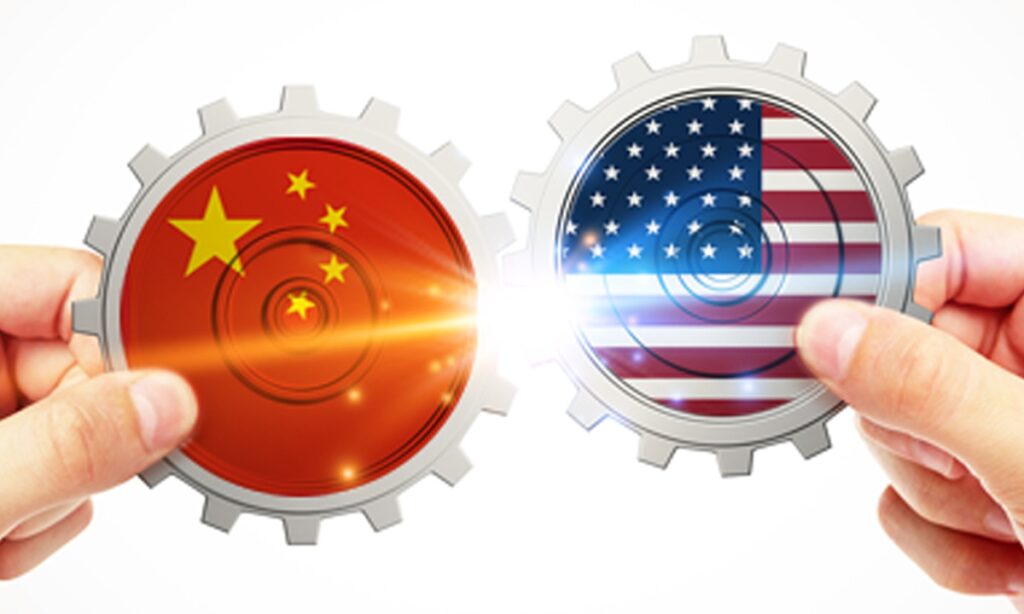US Commerce Secretary Gina Raimondo arrived in Beijing on Sunday night, kicking off a four-day tour that is widely anticipated to ease fraught relationship between the US and China, the world’s two largest economies. She was received by Director General Lin Feng of the American and Oceania Affairs Department of China’s Ministry of Commerce at the airport.
The visit, seen as a litmus test to see whether the US will show sincerity in fixing bilateral ties, is unlikely to witness big breakthroughs in the trade and commerce field between China and the US, Chinese experts said. However, the US move to pursue dialogue in a trek of recent high-level China-bound visits should be deemed positive in creating a better mood for further talks amid China-US ties that are still at the lowest ebb in decades.
US media outlets have expressed high expectations for Raimondo’s trip.
The New York Times reported on Saturday that Raimondo will likely be the “clearest demonstration yet of the balancing act the Biden administration is trying to pull off in its relations with China.”
Bloomberg reported on Saturday that “Raimondo may have the best chance among the Biden officials who’ve make the trek to China recently of taking the current tension between the world’s two biggest economies down a notch.”
Raimondo’s visit follows several high-level visits by US officials to China over the past three months or so. In June, US Secretary of State Antony Blinken visited China for the first time as the top US diplomat. In July, US Treasury Secretary Janet Yellen visited China. Also in July, US Special Climate Envoy John Kerry visited Beijing.
Compared with her peers, Raimondo, as the US commerce chief whose agency is primarily engaged in the field of economic and trade which represents the broadest cooperation and closest integration of China-US interests, is thus pinned with high hopes that her visit will reach some tangible outcomes as it concerns the pragmatic interests between the two countries.
During her China visit, Raimondo will travel to Beijing and Shanghai, and hold meetings with senior Chinese officials and US business leaders. She looks forward to having constructive discussions on issues relating to the China-US commercial relationship, challenges faced by US businesses, and areas for potential cooperation, according to the website of US Department of Commerce.
In her meeting with Chinese Ambassador to the US Xie Feng on Tuesday, Xie called on the US side to work in the same direction as China, lengthen the list of cooperation and shorten the negative list, so as to make joint efforts to stabilize China-US relations.
China will express its position to the US side on economic and trade issues of concern, and at the same time, looks forward to having in-depth discussions with the US on resolving economic and trade differences and promoting pragmatic cooperation, a spokesperson for China’s Commerce Ministry said on Thursday, ahead of the upcoming talks.
Further curbs warning
Despite the US showing positive signals in stabilizing bilateral ties via an array of small overtures including seeking a six-month extension of the US-China Science and Technology Agreement due to expire on Sunday, many experts in China have expressed their doubts about the US’ sincerity in pursuing dialogue with China because of US’ relentless crackdown on Chinese rising technology.
Big breakthroughs are not likely to be yielded from the talks, they said.
The extension of six months is a very well-studied result, Song Guoyou, deputy director of the Center for American Studies, Fudan University, told the Global Times. He called it a “smart and pragmatic” move for the Biden administration, which does not want to spoil the current positive atmosphere created between China and the US meanwhile giving itself some time to deal with mounting pressure from domestic lawmakers who want to scrap the agreement.
“The Chinese side is likely to express its biggest concern through the dialogue with Raimondo, which is the US’ continuous moves in curbing Chinese high technology development,” He Weiwen, senior fellow of the Center for China and Globalization, told the Global Times on Sunday.
The bulk of US’ restrictions against China including the entity list and export controls that have been imposed by Raimondo’s agency.
Earlier this month, Biden signed an executive order restricting investments in China, intended to further stymie China’s advances in cutting-edge technology areas including semiconductors and microelectronics, quantum information technologies and certain artificial intelligence systems.
Despite that the US Commerce Department’s Bureau of Industry and Security (BIS) announced that it will lift 27 Chinese entities out of the so-called Unverified List just ahead of Raimondo’s China visit, there are still more than 600 Chinese companies and institutions on the US’ entity list, which intends to cut off Chinese technology companies from obtaining relevant technology, equipment, funds and channels.
In a worrisome signal, the New York Times report said the US could expand restrictions on sales of chips, software and machinery to China’s semiconductor industry after Raimondo’s trip.
“If the two sides agree to settle certain specific issues through the dialogue, that will be a good start of improvement in the pragmatic terms,” He said. He noted that the establishment of a work group dealing with those issues including investment and export controls could also be possible in the following phase.
The US has sent a clear signal that the Biden administration wants to consolidate the stabilizing and improving momentum in bilateral relations, “at least not to make it spiral down for the moment till the Asia Pacific Economic Cooperation (APEC) Leaders’ Meeting when the two countries’ top leader are expected to meet,” Zhou Rong, a senior researcher at the Chongyang Institute for Financial Studies at Renmin University of China, told the Global Times on Sunday.
The APEC Leaders’ Meeting is scheduled to be hosted in San Francisco from November 12 to 18 this year. And recent frequent high-level contacts are thought to pave the way well for the possible meeting, according to Zhou.
“The US is still seeking to maintain a channel to hold talks with China and develop cooperation in some areas,” Zhou said, adding that the “areas” mainly refer to the ones that are in the US’ best interests.
Zhou warned that the US strategy in containing China’s rise in the technology and military sectors has not changed.
“During Raimondo’s China visit, China and the US are also expected to touch the ‘decoupling or de-risking’ claim,” He Wenwei said. The tone as hyped by some US politicians has posed challenges to businesses on both sides as it has roiled bilateral commercial and trade environment, He noted.
The US commerce chief is likely to reiterate the rhetoric that the US is not seeking an economic “decoupling” from China, the consequence of which is “disastrous,” just as warned by Yellen previously, according to He.
“Yet in the meanwhile, the US would also stress its national security concerns, a concept that has been abused in political operation to crack down on China’s high technologies,” He noted.
Li Haidong, a professor at the China Foreign Affairs University, told the Global Times on Sunday that “we are clear-minded on the US’ stance on its trade and commerce policies toward China and have forged our own judgment.” Also, the Chinese authority has well managed their expectations on Raimondo’s visit given the US’ repeated shifty moves toward China.
“If, during this visit, the US touts its ill-posed trade and economic policies toward China that is marked by strengthening ‘national security’ and alignment among its partners in a bid to marginalize China in a world trade landscape that Washington’s being pushing to reshape, then it will certainly ruin the talks, which is something that both sides don’t want to see,” Li said.
Trade between the world’s top two economies has been worsening since the start of the year as the US’ unrelenting trade and tech war against China has inhibited bilateral commerce.
Mexico and Canada have replaced China as the top exporters to the US. The US imported about $203 billion in goods from China in the first six months of the year, 25 percent less than in the same period in 2022, according to data from the US Department of Commerce.
(Global Times)




